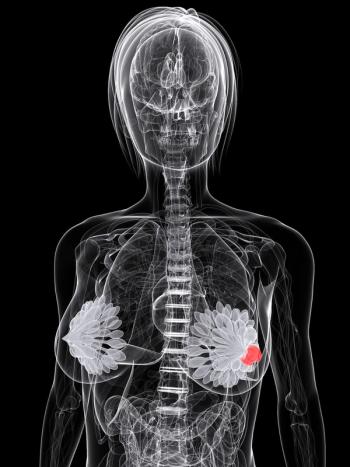
Early Activity of Neoadjuvant Niraparib in HRD+ Ovarian Cancer Reported in NANT Trial
Patients with BRCA-mutant, homologous repair deficiency–positive advanced resectable ovarian cancer may benefit from treatment with neoadjuvant niraparib, according to early results of a phase 2 trial reported at 2022 SGO.
Preliminary findings from the phase 2 NANT trial (NCT04507841) that were reported at
“Neoadjuvant niraparib monotherapy shows efficacy and tolerable toxicity in BRCA mutation, HRD-positive patients with advanced unresectable ovarian cancer,” said presenting author Qinglei Gao, MD, PhD, a professor with Tongji Medical College at Huazhong University of Science and Technology in Wuhan, China.
Among the 8 patients who have completed niraparib monotherapy, the objective response rate (ORR) was 75%. All responses were partial. “The maximum decline in target lesions was nearly 60%,” Gao added. “The R0 resection rate was 57.1% in 4 patients with BRCA mutation.”
Two patients (28.6%)—one with HRD-positive, BRCA wild-type tumors and 1 with BRCA mutation—had R1 resection and 1 patient (14.3%) with HRD-positive, BRCA wild-type tumors had R2 resection.
Patients aged 18-75 years with newly diagnosed HRD-positive, FIGO stage III to IV ovarian cancer were eligible for this multicenter, prospective, single-arm, open-label, study. Investigators determined HRD status by next-generation sequencing.2
Enrolled patients received niraparib at a daily dose of 200 mg or 300 mg for 2 four-week cycles. Following neoadjuvant niraparib treatment, patients exhibiting complete response, partial response, or stable disease will proceed to tumor reduction surgery and subsequent standard carboplatin/paclitaxel-based chemotherapy.
The primary end points include ORR and R0 resection rate. Secondary end points include rate of treatment interruption/termination, progression-free survival (PFS), overall survival, and disease control rate.
The study uses Simon’s optimal two-stage design, with 24 and 21 patients planned for the first and second stage, respectively. Five patients were necessary to determine preliminary ORR in stage 1 and 8 for stage 2. Gao presented results from stage 1 of the 2-stage trial. Investigators plan to present updated data after completion of stage 2.
The median age for these 8 patients was 51.5 years (range, 36-60), all of whom had high-grade serous carcinoma. Six (75%) patients had FIGO stage IIIC disease and 2 (25%) had stage IV. Five (62.5%) patients had an ECOG score of 1 and 3 (37.5%) had a store of 2. Similarly, 5 patients had BRCA mutations and 3 had BRCA wild type. All patients were positive for ascites.
Investigators measured CA125 levels every 2 weeks and observed a decline starting at day 14 after the first dose of niraparib. CA125 levels declined by a median of 57.6% following the first cycle of treatment and by a median of 88.5% following the second cycle.
Twenty patients were evaluable for treatment-emergent adverse events (TEAEs). Sixteen (80%) experienced any-grade TEAEs and 13 (65%) experienced grade 3 or higher TEAEs. The most common such events were hematological.
Anemia was the most common grade 3 or higher TEAE, followed by leukopenia and thrombocytopenia. Thrombocytopenia was most common following the first cycle of treatment, concurrent with the decline of CA125.
One (5%) patient required dose reduction. Twelve (60%) needed treatment interruption and 2 (10%) discontinued treatment. There were no treatment-related deaths.
In November 2021, Zai Lab Limited announced that topline data from the phase 3 PRIME trial (NCT03705156) First-line maintenance treatment with the PARP inhibitor niraparib (Zejula) yielded a clinically meaningful and statistically significant improvement in PFS compared with placebo in Chinese patients with platinum-responsive advanced ovarian cancer regardless of biomarker status.3
Results showed that the study met its primary end point of PFS and demonstrated a tolerable safety profile in those with newly diagnosed advanced epithelial ovarian, fallopian tube, or primary peritoneal cancer, following a response to platinum-based chemotherapy.
The PRIME study enrolled 384 patients with advanced ovarian cancer who achieved a complete response or partial response to first-line platinum-based chemotherapy. Patients were assigned niraparib or placebo until disease progression. The starting dose of niraparib was individualized at 200 mg except for in patients with a baseline body weight 77 kg or more and a platelet count of 150K/μL or more, in which case the starting dose increased to 300 mg.
Zai Lab plans to present the PRIME study data at a future medical conference.
References
- Yang Y, Zhang W, Liu R, et al. Effectiveness and safety of niraparib as neoadjuvant therapy in advanced ovarian cancer with homologous recombination deficiency: a prospective, multicenter, exploratory, phase 2 single-arm study (NANT). 2022 SGO Annual Meeting on Women’s Cancer. March 18-21, 2022. Phoenix, Arizona.
- Zhou D, Liu J, Liu R, et al. Effectiveness and safety of niraparib as neoadjuvant therapy in advanced with homologous recombination deficiency (NANT): study protocol for a prospective, multicenter, exploratory, phase 2, single-arm study. Front Oncol. Published online February 28, 2022. doi: 10.3389/fonc.2022.852772
- Zai Lab announces positive topline results from phase 3 PRIME study of Zejula® (niraparib) as first-line monotherapy maintenance treatment in Chinese women with platinum-responsive advanced ovarian cancer. Zai Lab. Published November 30, 2021. Accessed March 19, 2022. https://bit.ly/3I4Coof
Newsletter
Stay up to date on recent advances in the multidisciplinary approach to cancer.

















































































